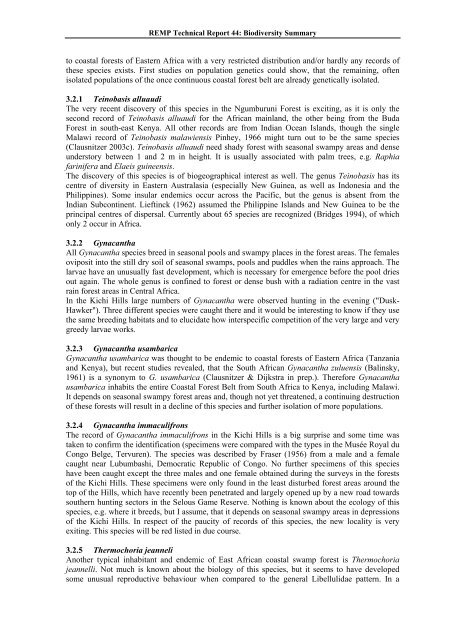Family / Scientific name - Coastal Forests of Kenya and Tanzania
Family / Scientific name - Coastal Forests of Kenya and Tanzania
Family / Scientific name - Coastal Forests of Kenya and Tanzania
Create successful ePaper yourself
Turn your PDF publications into a flip-book with our unique Google optimized e-Paper software.
REMP Technical Report 44: Biodiversity Summary<br />
to coastal forests <strong>of</strong> Eastern Africa with a very restricted distribution <strong>and</strong>/or hardly any records <strong>of</strong><br />
these species exists. First studies on population genetics could show, that the remaining, <strong>of</strong>ten<br />
isolated populations <strong>of</strong> the once continuous coastal forest belt are already genetically isolated.<br />
3.2.1 Teinobasis alluaudi<br />
The very recent discovery <strong>of</strong> this species in the Ngumburuni Forest is exciting, as it is only the<br />
second record <strong>of</strong> Teinobasis alluaudi for the African mainl<strong>and</strong>, the other being from the Buda<br />
Forest in south-east <strong>Kenya</strong>. All other records are from Indian Ocean Isl<strong>and</strong>s, though the single<br />
Malawi record <strong>of</strong> Teinobasis malawiensis Pinhey, 1966 might turn out to be the same species<br />
(Clausnitzer 2003c). Teinobasis alluaudi need shady forest with seasonal swampy areas <strong>and</strong> dense<br />
understory between 1 <strong>and</strong> 2 m in height. It is usually associated with palm trees, e.g. Raphia<br />
farinifera <strong>and</strong> Elaeis guineensis.<br />
The discovery <strong>of</strong> this species is <strong>of</strong> biogeographical interest as well. The genus Teinobasis has its<br />
centre <strong>of</strong> diversity in Eastern Australasia (especially New Guinea, as well as Indonesia <strong>and</strong> the<br />
Philippines). Some insular endemics occur across the Pacific, but the genus is absent from the<br />
Indian Subcontinent. Lieftinck (1962) assumed the Philippine Isl<strong>and</strong>s <strong>and</strong> New Guinea to be the<br />
principal centres <strong>of</strong> dispersal. Currently about 65 species are recognized (Bridges 1994), <strong>of</strong> which<br />
only 2 occur in Africa.<br />
3.2.2 Gynacantha<br />
All Gynacantha species breed in seasonal pools <strong>and</strong> swampy places in the forest areas. The females<br />
oviposit into the still dry soil <strong>of</strong> seasonal swamps, pools <strong>and</strong> puddles when the rains approach. The<br />
larvae have an unusually fast development, which is necessary for emergence before the pool dries<br />
out again. The whole genus is confined to forest or dense bush with a radiation centre in the vast<br />
rain forest areas in Central Africa.<br />
In the Kichi Hills large numbers <strong>of</strong> Gynacantha were observed hunting in the evening ("Dusk-<br />
Hawker"). Three different species were caught there <strong>and</strong> it would be interesting to know if they use<br />
the same breeding habitats <strong>and</strong> to elucidate how interspecific competition <strong>of</strong> the very large <strong>and</strong> very<br />
greedy larvae works.<br />
3.2.3 Gynacantha usambarica<br />
Gynacantha usambarica was thought to be endemic to coastal forests <strong>of</strong> Eastern Africa (<strong>Tanzania</strong><br />
<strong>and</strong> <strong>Kenya</strong>), but recent studies revealed, that the South African Gynacantha zuluensis (Balinsky,<br />
1961) is a synonym to G. usambarica (Clausnitzer & Dijkstra in prep.). Therefore Gynacantha<br />
usambarica inhabits the entire <strong>Coastal</strong> Forest Belt from South Africa to <strong>Kenya</strong>, including Malawi.<br />
It depends on seasonal swampy forest areas <strong>and</strong>, though not yet threatened, a continuing destruction<br />
<strong>of</strong> these forests will result in a decline <strong>of</strong> this species <strong>and</strong> further isolation <strong>of</strong> more populations.<br />
3.2.4 Gynacantha immaculifrons<br />
The record <strong>of</strong> Gynacantha immaculifrons in the Kichi Hills is a big surprise <strong>and</strong> some time was<br />
taken to confirm the identification (specimens were compared with the types in the Musée Royal du<br />
Congo Belge, Tervuren). The species was described by Fraser (1956) from a male <strong>and</strong> a female<br />
caught near Lubumbashi, Democratic Republic <strong>of</strong> Congo. No further specimens <strong>of</strong> this species<br />
have been caught except the three males <strong>and</strong> one female obtained during the surveys in the forests<br />
<strong>of</strong> the Kichi Hills. These specimens were only found in the least disturbed forest areas around the<br />
top <strong>of</strong> the Hills, which have recently been penetrated <strong>and</strong> largely opened up by a new road towards<br />
southern hunting sectors in the Selous Game Reserve. Nothing is known about the ecology <strong>of</strong> this<br />
species, e.g. where it breeds, but I assume, that it depends on seasonal swampy areas in depressions<br />
<strong>of</strong> the Kichi Hills. In respect <strong>of</strong> the paucity <strong>of</strong> records <strong>of</strong> this species, the new locality is very<br />
exiting. This species will be red listed in due course.<br />
3.2.5 Thermochoria jeanneli<br />
Another typical inhabitant <strong>and</strong> endemic <strong>of</strong> East African coastal swamp forest is Thermochoria<br />
jeannelli. Not much is known about the biology <strong>of</strong> this species, but it seems to have developed<br />
some unusual reproductive behaviour when compared to the general Libellulidae pattern. In a

















